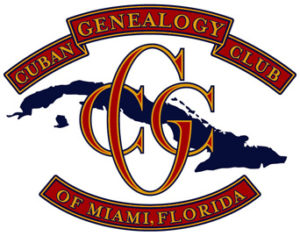El Caney Collection
collection: (noun) an accumulation of objects gathered for study, comparison, or exhibition
About this collection

DR. BOHUMIL BAĎURA (1929-2014)
The items in this collection were microfilmed by the Cuban National Archives for Dr. Bohumil Bad’ura, a Czech historian at Charles University in Prague, for his 2012 book, Paginas de la Historia del Pueblo del Caney, about the patterns of Indian land tenure in El Caney.
Our warmest thanks to Dr. Bad’ura’s widow, Agneska (Ines) Badurova, who kindly provided them to Juan Tamayo, a member of the Cuban Genealogy Club of Miami, Fl., Inc. (CGC), who in turn then donated the collection to the CGC.
IMPORTANT: These files are for personal use only! The use of the information on this site for commercial, political, or any other purpose other than research of your family history and genealogy is strictly forbidden.
Please contact and credit the CGC before using any part of this collection by emailing secretary@cubangenclub.org.
El Caney Padrones
Donated to the CGC by Juan Tamayo
1775 Padrón for El Caney
View our Census Page
1778 Padrón for El Caney
View our Census Page
1837 Padrón for El Caney
View our Census Page
El Caney
Document Collection
Donated to the CGC by Juan Tamayo
These are 2,418 pages from the Cuban National Archives, almost all of them are about San Luis de El Caney, a farming village on the outskirts of Santiago de Cuba that was a “protectorate” for Cuban Indians from around the early 1600s to around the first half of the 1800s. They are official government documents, largely dealing with issues such as land surveys, ownership disputes, rents and taxes paid and unpaid, and extremely legalistic and wordy correspondence among officials and entities of El Caney, Santiago de Cuba, Puerto Principe (Camaguey), Havana and Madrid.
The earliest refers to 1687 and the latest to 1879, but the bulk of the documents is dated 1800 to 1860.
The indexes were created by Juan Tamayo for his own family research. If you spot any mistakes, or have any comments, please contact him at Juantamayo@gmail.com
Read This First!
Seach Guidance
Spelling of surnames in the indexes is purely guesswork, especially the spelling of French surnames. Imagine a perhaps semi-literate Spanish official in Cuba writing down the names of also perhaps semi-literate French farmers expelled from Cuba in 1809-1810, or Irish carpenters living in Oriente about the same time.
- Juan Tamayo created the indexes over eight months as he searched for his own El Caney ancestors. He tried to decipher all the names, and took the best guesses possible, but did not include all the names in the indexes.
- Even when perfectly readable, spellings varied greatly. Telles was Tellez, Teyes and Teyez, Cisneros was also Sisneros and Acevedo was also Asebedo. The indexes include variants, when possible.
- When you search for names, search for as many variants as possible. And search for parts of the name, like CISN for Cisneros. The writers sometimes started the names correctly, then scribbled.
- Many of the documents are extremely difficult if not impossible to read. A few are as clear as modern handwriting.
- Many documents reference and at times repeat other, unknown, documents. For example, “Santiago orders el Caney to obey Letter No. 1331.”
- Some of the documents are barely legible in their original form. Some of them were badly photographed in Cuba. Some of the rolls of film were badly developed and show shadows, smudges, and water droplets.
- There are many copies of the same documents. Some copies may be better than others.
Microfiche Rolls
- Rolls are numbered in no special order. The first one digitized by Juan Tamayo was identified as Roll 1, and the last one as Roll 44.
- Some have no clear start or end, but the pages do appear follow in order.
Indexes
- Where possible, the start of a folder of documents was marked in the indexes as COVER, the start of each document within the folder was marked as START and the end of the document was marked as END.
- Many pages are labeled FORWARDING because they show officials simply confirming they received the document, passed it to another who also confirms receipt and forwarding, etc.
Possibly Interesting Content
- Some of the pages refer to Jiguani, Bayamo, Holguin, Guaninicu, Gibara, Jucaro, Manzanillo and Baracoa
- Roll 2 – Pg. 6 – Report that there are no more Indians in El Caney. Everyone is Spanish.
- Roll 2 – Pg. 27 – Indians suffer.
- Roll 2 – Pgs 33-76 has the 1784 census of El Caney, with full names of whites, slaves, and free blacks.
- Roll 6 – Pg 1-66 – Lists of foreign ship passengers who docked in Santiago on their way from Europe to US ports. No dates (appears to be 1848.)
- Roll 6 – Pgs 59-60 – sailing from Liverpool and landing in New Orleans on March 11, 1848.
- Roll 11 – Pg. 45-46 – Complaint that Spaniards are claiming to be Indians because they want the benefits of the protectorate. (Indians pay no property taxes.)
- Roll 31 – Several lists of taxpayers
- Roll 38 – Lists of French expelled from Cuba 1808-1810.
- Roll 38 – Pg. 15 – A list of French passengers who sailed to Louisiana aboard the US brigantine “Philadelphia.” List of French residents of Holguin.
- Roll 39 – List of landowners and renters, apparently most of them in El Caney and some in Hacienda Santo Domingo in Villa Clara.
- Roll 41 – List of French living in Cuba 1808-1809.
- Roll 41 – Pgs 109-117 – lists of foreigners who have legal residence in Cuba, including French, (many) Irish, Americans, Italians, Germans, etc.
- Roll 41 – Pgs 132-127 – Appointment of new U.S. consuls for
Cuba. - Roll 43 – Lists of French who sold their lands during expulsion.
